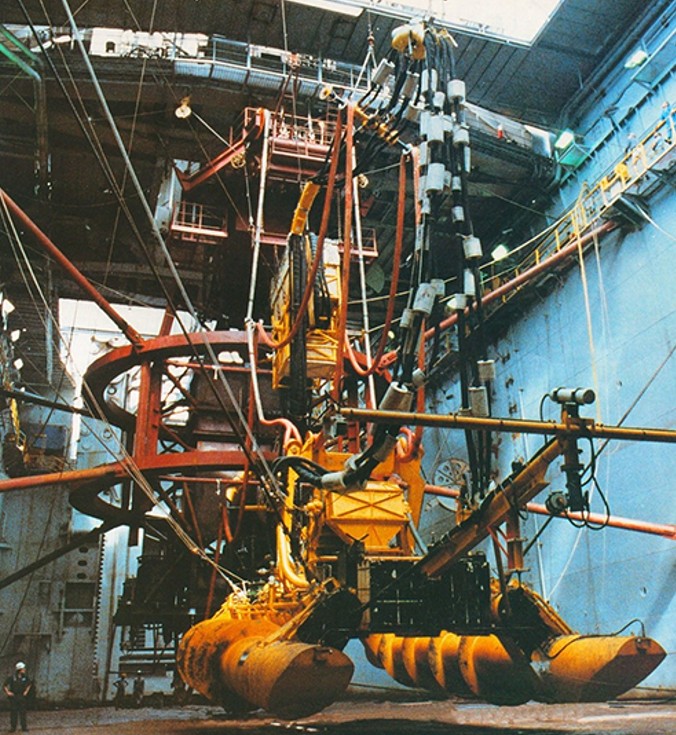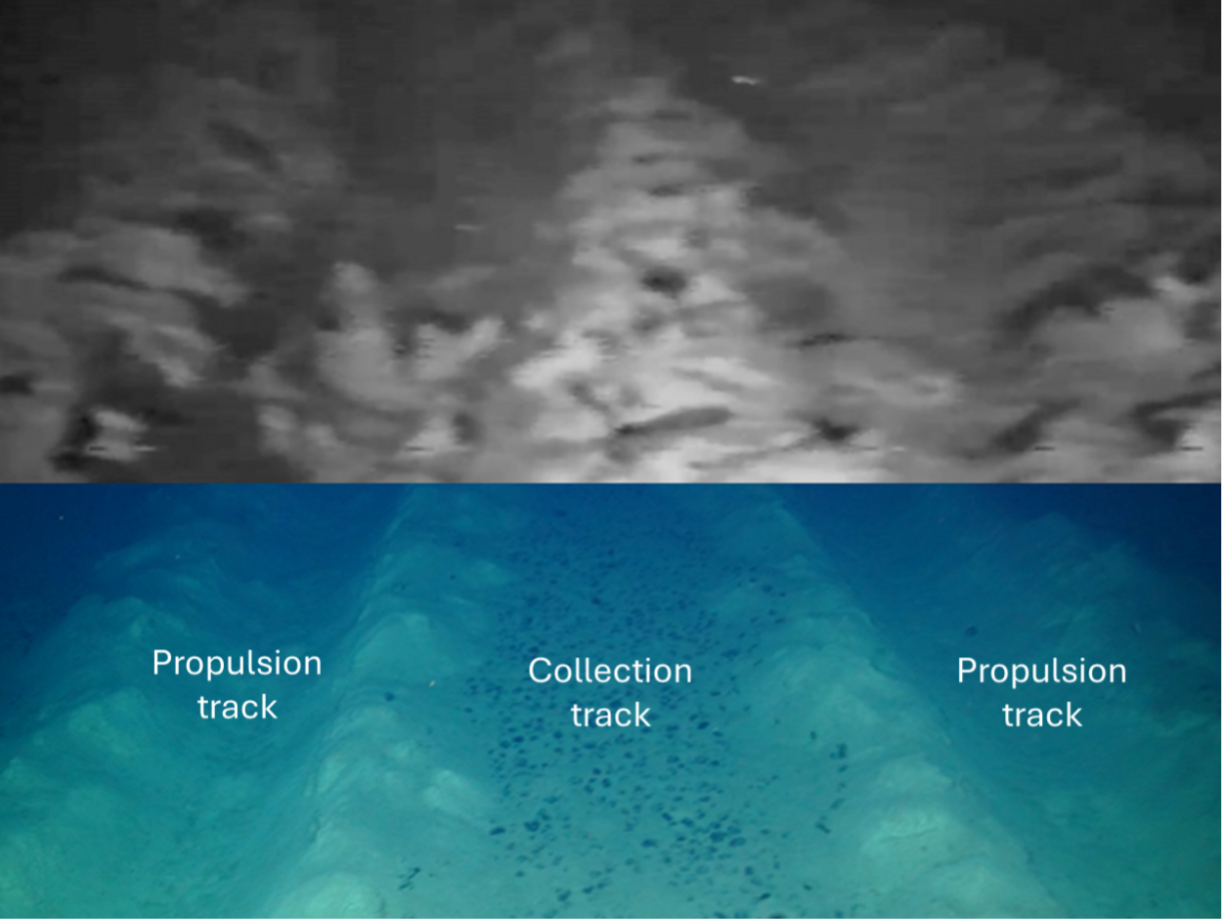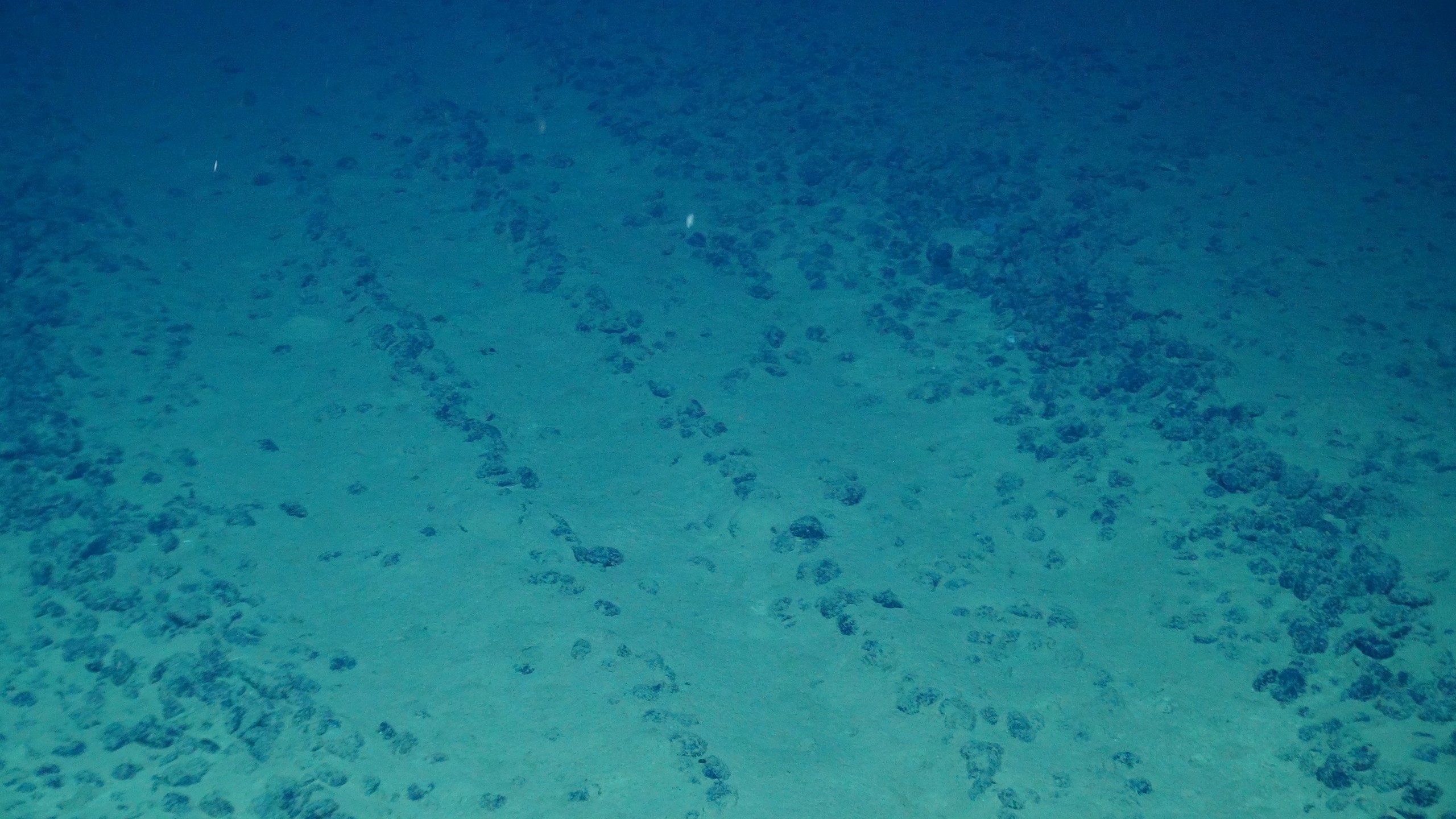In 1978 and 1979, the Ocean Minerals Company (OMCO) trialled the extraction of polymetallic nodules in the Clarion Clipperton Zone. An experimental mining vehicle was lowered to the seabed 4,700 meters beneath the ocean surface. The vehicle was then driven in a long, narrow 3.7 kilometer loop over the course of 4 days, collecting and crushing polymetallic nodules before they were passed to a surface vessel through a riser and buffer system.
The vehicle used, while considered groundbreaking at the time, disturbed the seabed more than the technologies now being considered for nodule collection. For example, twin 2 meter-diameter Archimedes screws were used to propel the OMCO vehicle, churning the seabed in the process and causing far more disruption than modern track systems do.

Collector vehicle used for OMCO trial. Twin two meter-diameter Archemedes screws were used to propel the vehicle and in between these was a collector head designed to pick up nodules from the seafloor.
Nonetheless, revisiting the site of this trial has given scientists a valuable opportunity to study the potential long-term impacts of commercial-scale polymetallic nodule collection on deep-sea ecosystems.
In March 2023, scientists returned to the OMCO trial site to assess the long-term ecological impacts within the collection tracks, the vehicle propulsion tracks, and the sediment plume area by comparing the test site with a control area around 2 km away. Their study has so far resulted in a peer-reviewed paper, published in Nature, entitled Long-term impact and biological recovery in a deep-sea mining track. The key findings of this study are summarized here.
Nodule collection track
An approximately 4.5 meter wide area was passed over by the OMCO vehicle collector rake, creating a nodule collection track. Vehicle propulsion tracks can also be seen along the sides of the nodule collection track. Physical changes have persisted since 1979, with the appearance of this area relatively unchanged. (This may put one in mind of footprints in the Moon resulting from the Apollo missions between 1969 and 1972 which persist to this day).

Image of OMCO tracks in 1979 (top) and 2023 (bottom). The propulsion tracks were created by the Archemedes screws used to propel the vehicle, while the collection track was caused by the collector head of the vehicle.
Organic carbon content and microbial biomass
Where nodules were removed, the sediments in the collection tracks have “generally lower and more variable organic carbon content compared to other areas of the seabed. However, small organisms living in sediment, such as annelids, arthropods and molluscs, were present in broadly similar” densities to the undisturbed control site. In 2023, it was found that microbial biomass was also similar inside and outside the tracks.
Nodule-dwelling biota
Organisms living on polymetallic nodules were also found in similar densities in the test site and the control site, although the 1979 technology was inconsistent with respect to its nodule pick-up abilities within the collector tracks. Using modern technologies, where the removal of nodules is achieved more efficiently, it is likely that there would be further reductions in nodule-dwelling biota density in the tracks.
Megafauna (biota over 1 centimeter in size)
Few examples of larger organisms were found in the collection tracks, with the exception of xenophyophores. Although found at lower densities than in other regions, these organisms reached diameters of 50 millimeters, and “appear to be the first sessile megafaunal-sized organisms recolonising the mining track disturbance area”. Overall, the density of larger organisms within the tracks in 2023 was far lower than pre-trial levels recorded in 1978 and in the 2023 control region.
Vehicle propulsion tracks
The Archimedes screws which propelled the 1979 OMOC collection vehicle created significant disturbance to the seabed by displacing sediment into banks which run parallel to the tracks. These formations were still visible in 2023.
Densities of larger organisms found within the propulsion tracks in 2023 are lower than found the control area and the 1978 pre-test site, but higher than in the collection track.
However, the authors acknowledge that “these propulsion tracks appear to create a considerably larger level of disturbance than planned modern tank-track propelled collection vehicles”, which will cause far less sediment to be displaced.
Sediment plume area
Although a sediment plume was observed during the 1979 trial, there appears to be little persisting physical impact on the area the plume would have covered. Visually, the seafloor adjacent to the tracks, which remains covered in polymetallic nodules, is not discernible from other areas. This suggests that sediment suspended in the test was redistributed or dispersed in the decades following the OMCO test.
The plume was not found to have lasting adverse effects on larger organisms living on the seafloor. In fact, “the plume area had elevated densities of megafauna in 2023 … compared with both the track and control areas.”
Conclusion
While the physical signs of seabed disturbance remain 44 years after the OMCO test, some life has returned, with the authors noting “sediment and nodule macrofauna densities and microbial biomass are similar in and out of disturbed areas.” Mobile organisms were found to be living in even the areas most effected by the 1979 trial, and there is evidence of sessile species being re-established.
The paper concludes that proactive measures, such as reducing the direct impact of collection vehicles and setting aside a network of protected areas, could be effective in limiting the overall ecological effects of mining operations on seafloor biota.
References:
Image at top of page: Seabed taken by ROV during the SMARTEX expedition JC241 to the 1979 OMCO test site in the Clarion-Clipperton Zone (Pacific Ocean, 2023)

